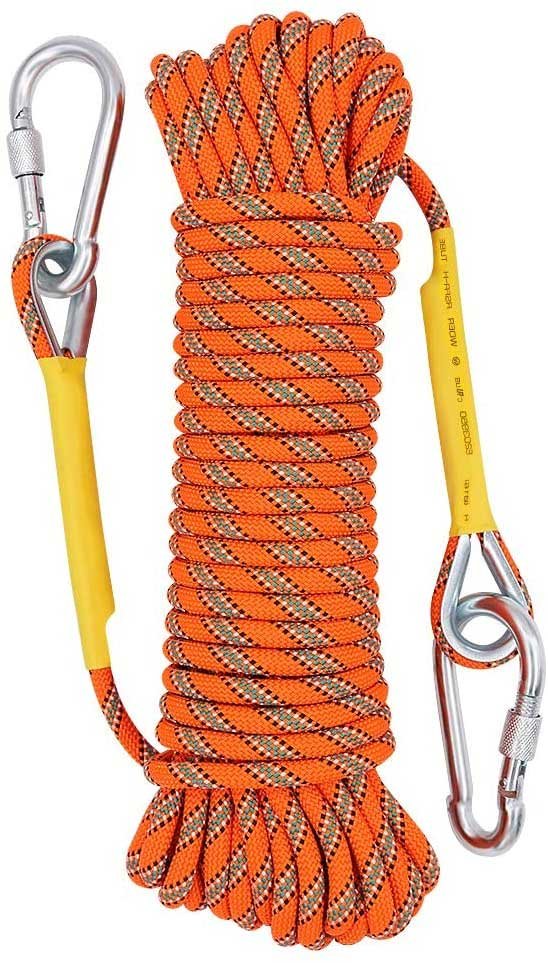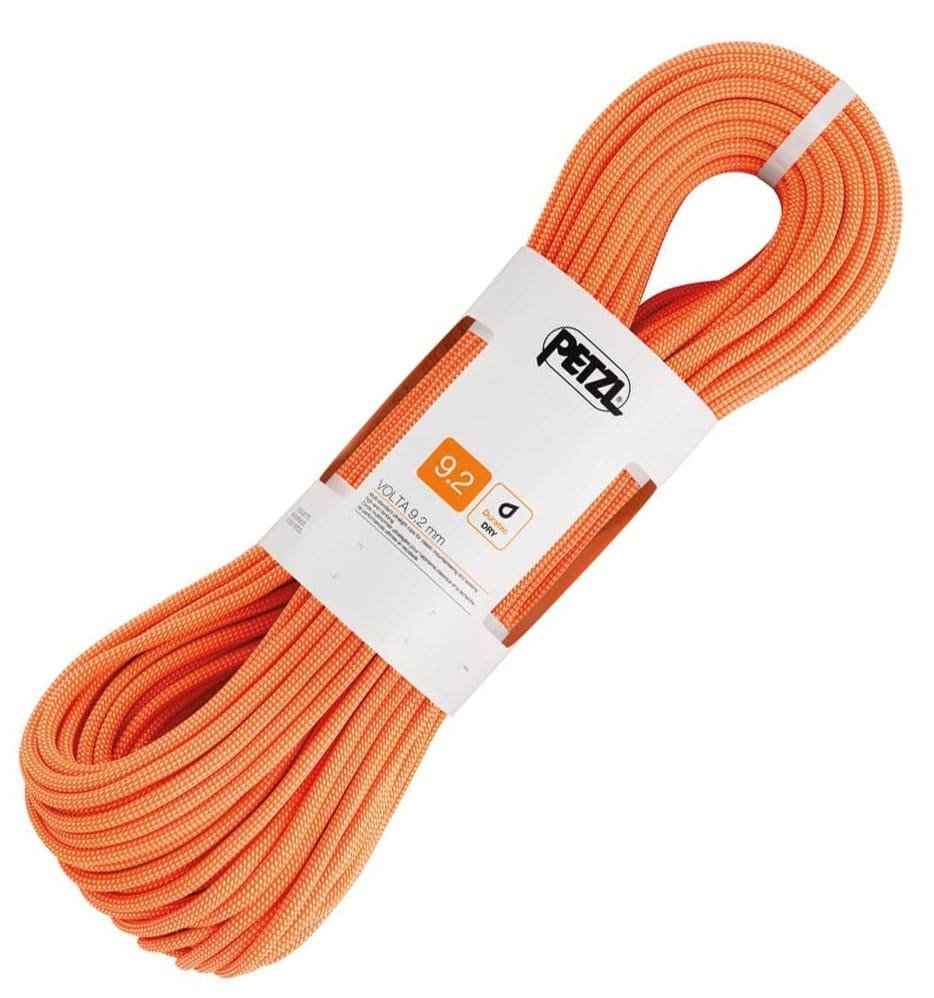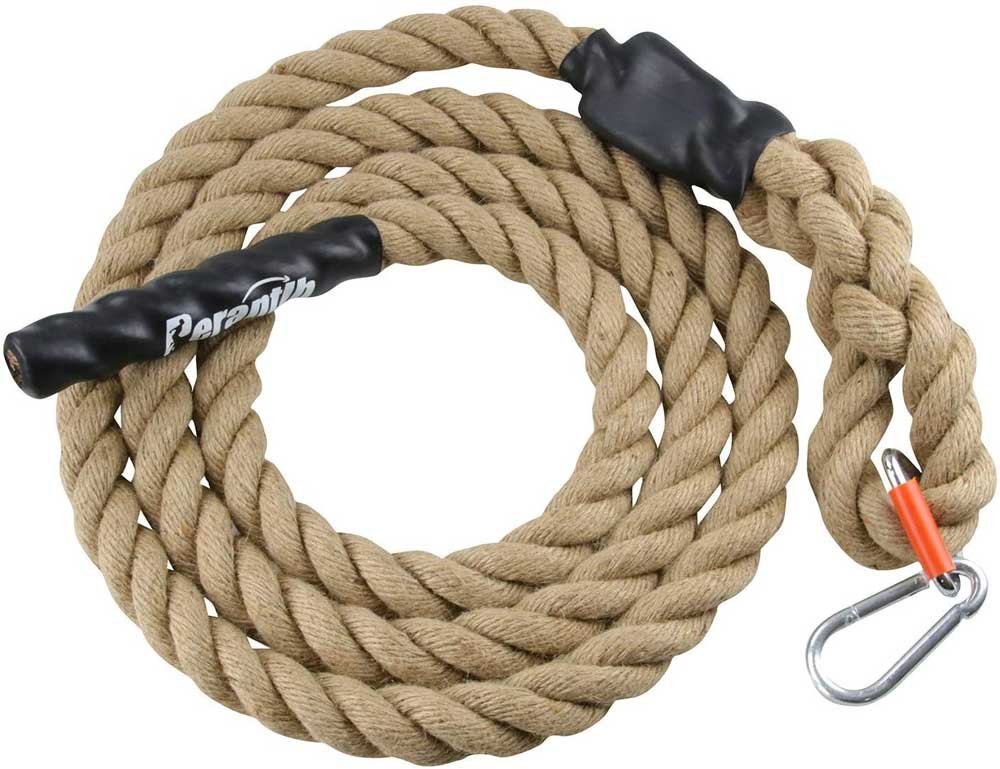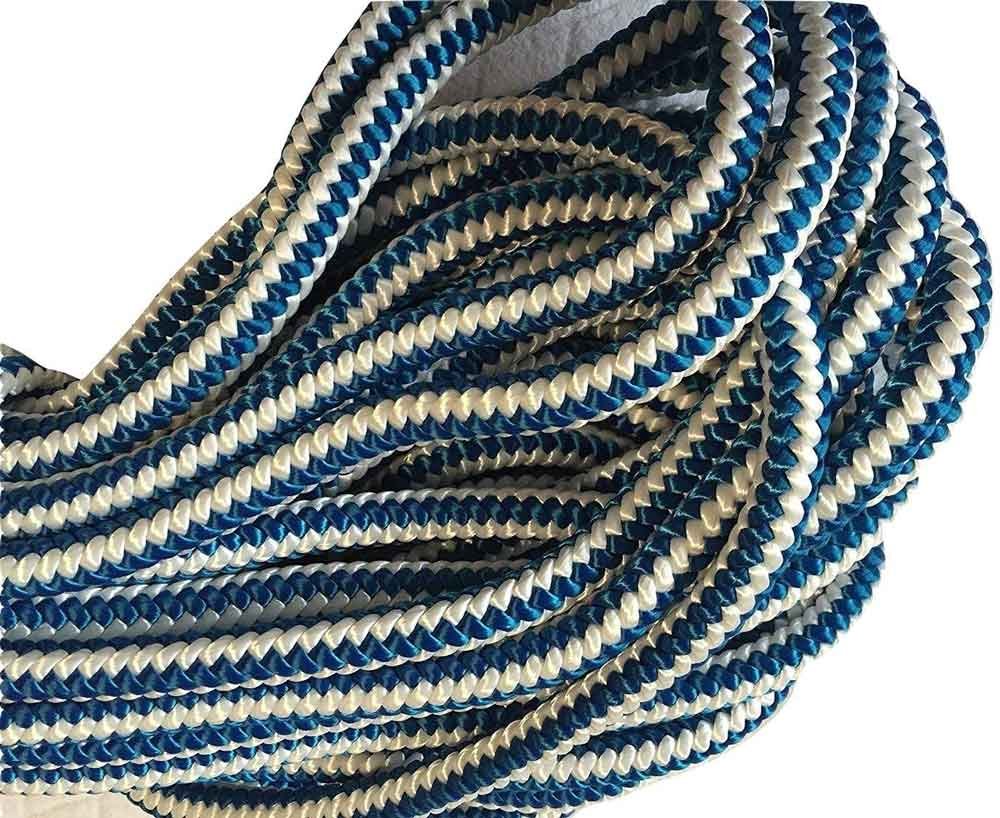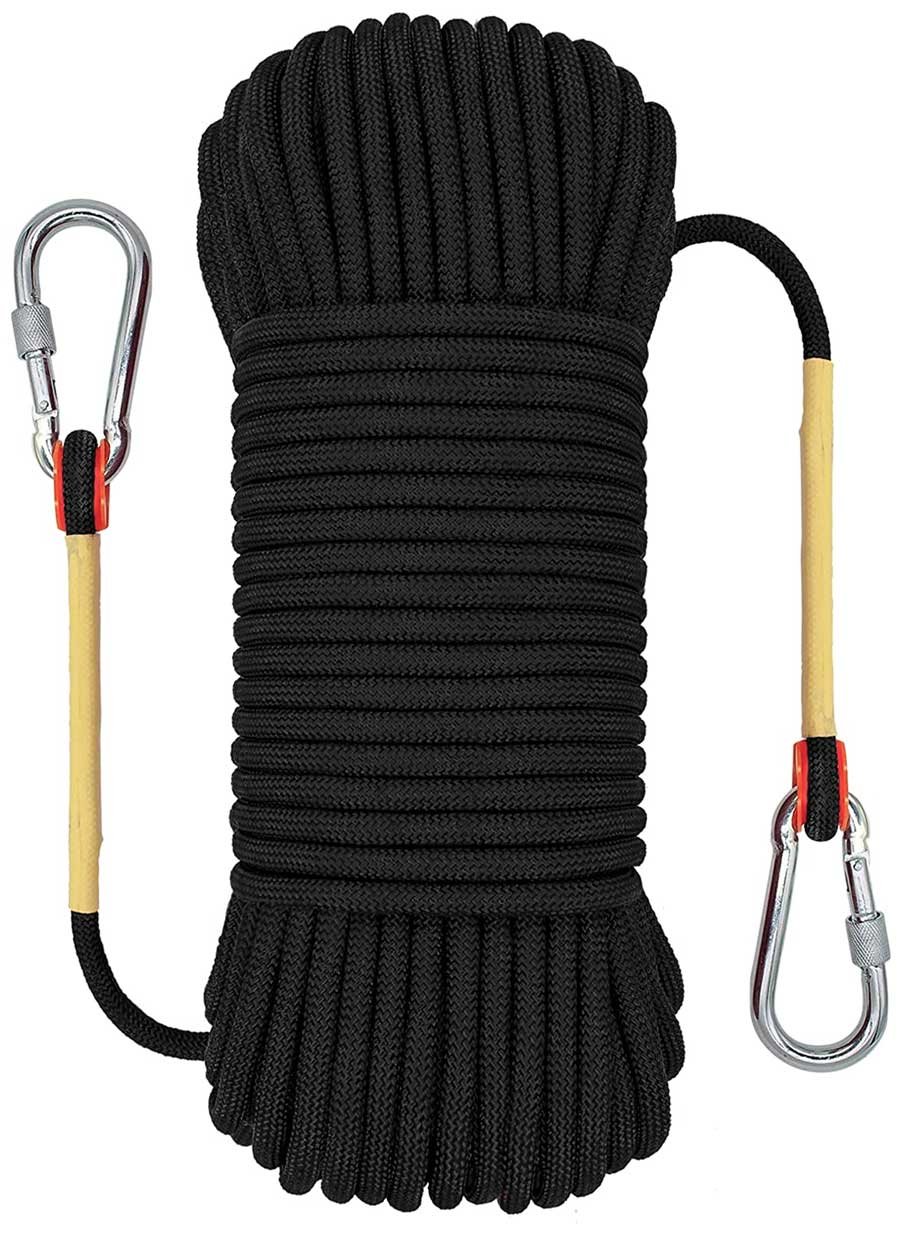Buying the best climbing rope can be a tough and challenging job. The rope for climbing must be the best because of the paramount importance of safety and security in climbing adventures.
This is what this article is about. We have made the list of the best climbing ropes. These ropes have the top features that the climbing ropes need. We have selected these based on the highest reviews they received.
You will find a comprehensive buying guide, a care guide, and a guide on washing the climbing rope in this article. And we have answered some FAQs as well.
Let’s not keep you hanging and see the top-rated climbing ropes.
Top Picks of the Best Climbing Ropes
Let’s not add any more layers between you and the climbing ropes and get you straight to the best climbing ropes!
X XBEN Best Outdoor Climbing Rope
This first rope is the highest-reviewed climbing rope on our list. It has ticked all the boxes of all the premium features that you expect to see in a climbing rope.
The rope is made with 13 whole core ropes that give it impressive durability and strength. It has a low outer skin sliding rating, less than 0.05%! This makes the X XBEN Outdoor Climbing Rope a smooth rope for climbing.
The diameter of this rope is 8 mm, and the impact force rating is 15 kN. X XBEN Outdoor Climbing Rope has a weight capacity of 300 kg.
The design of this X XBEN Outdoor Climbing Rope is professional. The climbing rope has low ductility and reduces the risk of extension at an unwanted time. It is light and easy to carry. Many experienced climbers have used this rope for Escape, Fire Survival, Backup, Climbing, Hiking, Camping, Downhill, Engineering protection, Lanyard, Tree Stand Accessories, Training, Aloft work, Caving, Abseiling, SRT, etc.
The rope comes in 32ft, 64ft, 98ft, 160ft in length. It is well twisted and has higher wear resistance. This static rope has an affordable price tag.
Pros
- Number one rope, most reviewed among all the ropes
- Skinny ropes for the best climbing sports
- Preferred by advanced climbers, and amateurs
- Great climbing rope with a high fall rating
- Zero rope stretches for catching falls
- Avoid rope drag with a low outer skin sliding rating
- Thinner rope with great durability
- Affordable lightweight rope with the middle point marker
Cons
- A static rope; that limits the use
PETZL Volta 9.2 mm Dry Dynamic Best Single Climbing Rope
This is one of the most premium ropes on our list. The brand is also a very reputed one in the climbing sports world.
The PETZL volta rope is an ultrathin rope that is for an elite climbing experience. It can be used as a belay device or for climbing rock, mixed, snow, or wet conditions.
This ultrathin ultralight rope features a Duratec double dry treatment; dry treatment makes the rope more resistant to water, dirt, and abrasion. This feature makes the rope more comfortable and gives more grip, and handling in extreme weather.
Such a skinny rope can be highly durable that it almost defies all notions of common sense. But it is very durable, being such a thin rope. Petzl volta rope does that by using an ultrasonic finishing process that makes both the sheath and rope core bonded by an ultrasonic process. This gives the rope durability and prevents frayed ends.
The middle mark allows you more maneuver and makes it an effective belay device. Petzl volta rope comes with EverFlex special thermal treatment that stabilizes the core strands and improves consistency; it offers excellent grip and consistent handling over time.
It is available in many sizes, and the price can be a bit high, to be fair.
Pros
- Such a skinny rope for top-roping,
- Easy to handle ropes
- Easier rope management to climb indoors
- Duratec Dry treatment, dry treated for wear and tear resistance
- Preferred by advanced climbers, and amateurs
- Core and sheath bonded by ultrasonic finish; gives greater durability and avoids frayed ends
- High own fall rating grams per meter
- Non-stretchy for catching falls
- Everflex special Thermo shield treatment for additional grip and security
Cons
- Expensive climbing rope
Perantlb Outdoor Best Jute Climbing Rope for Fitness and Strength Training
The next climbing rope on our list is Perantlb Outdoor Climbing Rope. It comes with a great number of reviews and good rope features as well.
There are 8 lengths of ropes available for you to choose from- shorter rope sizes of 8ft, 10ft, 15ft, 20ft, 25ft, 30ft, 40ft, & 50ft. These ropes are perfect for both professional and amateur sports lovers of all ages.
The material is natural jute; this makes the rope very durable and soft to touch. The rope is remarkably strong, and the weight capacity is 500 pounds.
The top ropes come with heat shrinkable end caps and are equipped with high quality rubber caps that prevent wear and tear. There are eagle eye hooks that allow you to attach the rope to an anchor point easily.
There are other sized rope options and hook options available for you. This climbing rope guarantees satisfaction.
The rope’s price tag depends on the size, but it is affordable in all sizes.
Pros
- Natural jute rope for top-roping
- Eagle eye hook for climbing sports
- Preferred by advanced climbers, and amateurs
- High fall rating grams per meter
- Non-stretchy to soft catch falls
- End caps and rubber caps for preventing wear and tear
- Affordable
Cons
- Static rope limits the heavy use
Blue Ox Arborist Best Durable Climbing Rope
This is the next climbing rope on our list. It comes with many features that we will have a look at.
This is a 12 strand polyester rope. Polyester is a flexible but durable and strong material that is almost as good as nylon. This makes the rope durable and gives it a long life span.
The tensile strength of this rope is 8000 pounds, the highest on our list so far. The climbing rope allows easy handling, and good knot retention.
The ropes are very resistant to milking, abrasion, stretching, and fading. They are bi-pattern ropes with very good tensile strength.
The climbing rope comes in a 200 feet length, and the price of this rope is on the higher side of price tags.
Pros
- 12 strand polyester rope
- High tensile strength for top roping
- Preferred by advanced climbers, and amateurs
- Durable and abrasion resistant
- High fall rating grams per meter
- Non stretchy for catching falls
Cons
- Expensive
GINEE Best Static Climbing Rope
Ginee static climbing rope is the next one on our list.
GINEE climbing rope comes with 10 mm and 16 mm diameter and lengths of 35 feet to 250 feet. These are made with multi core multi layer polyester.
The rope features 2 plastic protection rings, 2 buttonholes. This rope is perfect for Rock Climbing, Tree Climbing, Magnet Fishing, Rescuing, Escaping, Camping, Hiking, Engineering protection, etc.
This climbing rope is very durable and of high strength. And it comes protected with a warranty.
The price of this climbing is very affordable.
Pros
- Multicore multi layer polyester
- Features 2 plastic protection rings, 2 buttonholes
- Preferred by novice climbers, and amateurs
- Durable and abrasion resistant
- High fall rating for multi-pitch climbs in long multi-pitch routes outdoors
- Non-stretchy for catching falls
Cons
- Static rope limits the use somewhat
Black Diamond 9.4 mm Best dry treated Climbing Rope
This is the second from Black Diamond climbing rope on our list. This one is a top-notch rope because Alex Honnold is seen using this rope for his climbing.
This is a dry-treated rope that features a stretchy core and rope’s sheath that are dry treated. This makes the rope durable and protected against weather and abrasion. The Black Diamond brand, as we know, is very famous for its quality control and inspection of its climbing gear.
The rope features a 2×2 woven durable sheath; this makes the rope very durable and useful in all weather. The standard sheath allows the rope to withstand everyday rough rock climbing uses.
The rope is very good and is made to ensure the perfect balance between durability and easy handling. The rope is not too stiff nor too soft. This makes the rope perfectly comfortable for your hand.
The softness of the rope makes it easier to knot and feed through belaying devices. But it is strong enough for a long time to use for climbing, rock climbing, and tree climbing.
The price tag of this rope is a bit high. But the quality and the fact that this rope is the go-to rope for professional advanced climbers like Alex Honnold makes it a very high quality rope, and the purchase a very good deal! Buy now while it is still available.
Pros
- Preferred by advanced climbers, and amateurs
- Non-stretchy for catching falls
- Durable outer sheath
- High tensile strength, dry treated ropes
- High fall rating, durable climbing ropes
- Durable and abrasion resistant
- Great rope with 2×2 weave construction
Cons
- Expensive climbing rope
- No rope bag or dry cover
Sterling Ropes Velocity 9.8 XEROS – Blue 40m – Best Climbing Rope
Sterling Fusion Nano IX is the rope that comes very highly recommended by climbing experts! This rope is the thinnest rope on our list. Such a thin rope can pack so many features; that was news to us!
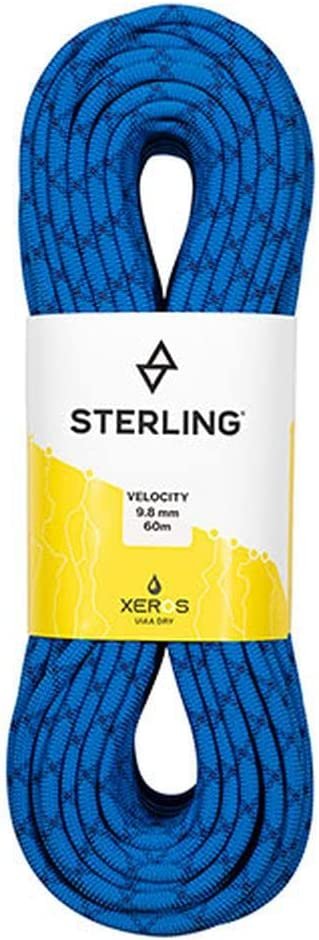
This is a Dynamic rope with varying types of rope. It is a single, half, and twin rope. This rope is extremely lightweight and easy to carry. But the durability of the Sterling Fusion Nano IX is unbelievably high.
It has a smooth thick sheath that allows smooth operation and doesn’t hurt your hands and has a supple feel. It makes using it with a belaying device easier. You can use this rope for all types of climbing.
This Sterling Fusion Nano IX climbing rope is UIAA certified. It can withstand much tensile force, and has proper dynamic elongation and static elongation.
Sterling Fusion Nano IX is water repellent. The Nano IX is perfect for mixed routes, ice climbing, glacier crossings, and alpine climbing.
The price of this highly recommended rope called Sterling Fusion Nano IX is a bit high. But the durability and functionality of the climbing rope make it a perfectly reasonable price.
Pros
- Ultra-thin ropes, preferred by most climbers
- Lighter weight rope, dry treated rope
- Excellent rope with silky smooth sheath
- UIAA certified for water repellency
- Preferred by advanced climbers, and amateurs
- High fall rating, great for alpine climbing
- Non-stretchy to soft catches in falls
- One of the finest rock climbing ropes
Cons
- Not double dry ropes
Black Diamond 9.9 Mm Best Abrasion Resistant Climbing Rope
Black Diamond climbing rope comes from a brand that produces the highest quality climbing gear. This is one of their most premium ropes on the market.
This rope comes in 35 m in length, with a diameter of 9.9 mm. It is made with a 2×2 weave construction. It has longevity and durability.
The rope is perfect in softness and stiffness, and that makes it perfect for climbing. You can tie knots more easily, and it feeds easily through the belay device very easily.
The price of this rope is in the mid-range, and you have options of sizes available for you.
Pros
- 2×2 weave construction, like most ropes from the brand
- High tensile strength
- Preferred by advanced climbers and amateurs as a new climbing rope
- Durable and abrasion resistant
- High fall rating
- Non-stretchy for catching falls
Cons
- Great rope but expensive
OXYVAN 10mm Finest Climbing Rope – 32ft
You may use the OXYVAN 10mm Rope with steel carabiners for tree climbing, transporting cargo, hanging gear, or fleeing danger when you require a rope of this size. It is important that the carabiners are strong and long-lasting because of this. A revolving carabiner lock maintains your carabiner attached to your rope.
It is attached to a cord that is made of two braids with distinct textures. By using a perfect weave, the rope retains its roughness and increases its strength. This gymnasium climb rope is top-notch because of its reduced slipping rate and a featherweight feel.
The carabiner’s barb construction is more solid, making it less likely to break off if the lock is bent, assuring your safety. Because the rotating section is much broader than the typical lock head’s crown, it is much more comfortable to operate.
Sliding is less than 0.05 percent using OXYVAN’s external static climbing rope, which has a tightly bound outer layer, clear appearance, and low slipping rate Durable and light, the rope is meticulously weaved from 48 strengthened inner cores.
Two metal carabiners, two plastic protection rings, and two buttonholes were sewn into each end. Pull (maximum tensile force): 10KN (2200lbs), diameter: 10mm, and Maximum allowed weight: 300 kg (660lbs).
Polyester and polypropylene are used in the construction of the nylon rope. For a long-lasting and sturdy product, with strong wear resistance and a solid braided sheath.
Static wire rope with low ductility reduces the likelihood of wire rope elongation. With a modest size and lightweight, it’s very easy to roll up and store It’s simple to maintain things neat and spotless for the most part.
Three huge core ropes make up the rope. Water-resistant, soft, and more wear-resistant are only some of the advantages of stitching accuracy. Pilling is difficult, but the brakes still work well.
Aside from the obvious applications in mountaineering and outdoor activities like hiking and camping, they’re also fantastic for pets and may be used as a hoist device on boats, caverns, and in the deep underground for fishing and exploration.
Pros:
- Two metal carabiners
- two plastic protection rings
- Polyester and polypropylene are used in the construction
- maximum tensile force: 10KN (2200lbs)
- Maximum allowed weight: 300 kg (660lbs)
Cons:
- Length options are a bit awkward
Best Climbing Ropes Buying Guide
Given the importance of a climbing rope, it is vital to know what to look for in a climbing rope. It is directly related to your safety and security. But it is not an easy job to select the best climbing rope.
Especially, for the amateurs and beginners, who don’t know what features mean and what advantages, buying the right climbing rope can be a hard job. Advanced climbers do not always face this problem, but the percentage that faces this problem is non-zero.
This segment discusses the various types of climbing ropes on the market and what means what in climbing terminology. We hope this comprehensive guide can be exactly what is needed for all amateurs and advanced climbers alike.
Here we go!
Types of Climbing Ropes
Two main types of climbing ropes are needed in climbing. Each has its uses and some disadvantages.
i. Static Ropes
As the name suggests, these ropes have less stretch. These ropes are ideal for caving activities, rescue situations, and hauling gear for hauling up loads. These are not perfect ropes for rock climbing. But these ropes are there on the market, and it is handy to keep around while climbing nonetheless.
ii. Dynamic Ropes
Again, as the name suggests, these ropes are more vibrant and dynamic. This means that this rope has more stretch, allowing the rope to absorb shock and impact. These ropes are perfect for top-roping, hard sport climbing, trad climbing, lead climbing, and other outdoor climbing activities.
You can use both dynamic ropes and static ropes together while climbing.
Climbing Rope Diameter
The diameter of the rope is another vital consideration for buying climbing ropes. Depending on the type of rope, the diameter can be different. The diameter of the rope gives the rope strength and stability.
There are many ranges of diameter that are used for many ranges of climbing.
i. 9.8 mm to 10.2 mm
These are the thickest ropes available on the market. These diameter 9.8mm ropes are perfect for gym climbing ropes, indoor climbing, aid climbing, top climbing, and rock climbing. The thick diameter allows you to climb more and gives the rope extra strength and stability.
ii. 9.5 mm to 9.8 mm
These types of ropes are all-around ropes. You can use the diameter 9.5mm ropes for all types of climbing. These are durable ropes for climbing. They are light and easy to handle. These are the perfect rope for trad climbing and sports climbing.
iii. 9.4 mm
These ropes are also known as single ropes or skinny ropes. These surprisingly durable skinny ropes are perfect for multi pitch climbing, alpine climbing, and other sport climbing types that deal with elevation.
These ropes are known for their lightweight. But are less durable than thicker rope.
iv. Half and twin ropes
The half ropes have a diameter of 8 mm to 9 mm. The twin rope falls in the diameter range of 7 mm to 8 mm.
Rope Length
Rope lengths are also very important buying considerations. The standard rope length is 60 m. But many crags are around that require a 70 m rope to lower back to the ground.
The available rope length in the market can vary from 30 m to 80 m. You should go for the one that is more convenient for you.
It is important to check the crag before buying a rope for climbing for that particular area.
Rope Weight
Rope weight is important when considering the strain it can cause on the climber when carrying the rope during a climb. The weight of the rope depends on its length and diameter of the rope. A rope with a smaller diameter will be generally lighter than larger diameter ropes.
But other factors contribute to the weight. The core of a rope can be a significant factor in a rope’s weight.
The standard weight, in this case, is measured in grams per meter in dynamic rope and gram per foot in static rope.
Rope Coating Types
Some rope comes with a dry coating called dry treated ropes. This helps the rope resist and repel water. If you are willing to use the rope for ice climbing or alpine climbing, you should go for a dry treated sheath.
If your rope has no coating, it can swell from water absorption and get waterlogged. These coating can also be very useful for abrasion resistance for rock climbing and can slide easily through a belaying device with smoothness.
Single, Double, and Twin Ropes
The great majority of climbers purchase single rope. The term ‘single’ refers to the fact that the rope is intended to be used singly rather than in conjunction with a different rope, as is the case with certain other rope kinds.
The fact that single ropes can be found in a broad variety of sizes and lengths means that they may be used for a wide variety of climbing disciplines, and they are typically easier to manage than two-rope systems.
Some single ropes are also rated as half and twin ropes, allowing you to utilize them with any of the three climbing techniques that are now available. It’s critical to only use a rope in the manner in which it was intended and tested for usage.
Single ropes are identified by the presence of a circled 1 at either end of the rope.
Half or double ropes are those ropes that are medium in the diameter range and are meant to be used simultaneously. These ropes are low weight and preferred by the alpine climbers to reduce the pack weight and drag on the back.
Twin ropes are even lighter and smaller in diameter ropes. These ropes have to be clipped simultaneously as well. These are the preferred ropes for trad climbers and ice climbers.
These ropes have added security for the climbers.
Rating of Climbing Ropes
The Union Internationale des Associations d’Alpinisme (UIAA) is the worldwide mountaineering and climbing association that develops safety criteria that must be adhered to by all climbing ropes used on the mountainous terrain of the world. Third-party laboratories carry out the testing under independent supervision. The UIAA tests are passed by all of the dynamic ropes carried by REI.
When purchasing dynamic climbing ropes, be sure to check the package for the test results for UIAA safety requirements, which include fall rating, static elongation, dynamic elongation, and impact force, among others. When considering what sort of climbing you will be performing, it might be helpful to look at these ratings to assist you to pick the right rope.
I. UIAA Fall rating
The UIAA puts ropes through their tests to measure how many falls they can withstand before breaking. The power of the lab falls far larger than the force of most real-world climbing falls. The fall rating is mostly a comparison value as a result of this.
Single rope is tested by dropping an 80kg weight onto the rope, half ropes are tested by dumping a 55kg weight on a single strand, and twin ropes are tested by dropping an 80kg weight on two strands. Half ropes are tested by dropping an 80kg weight on a single strand. The UIAA requires that all single ropes and half ropes be capable of withstanding at least 5 UIAA falls. Twin ropes must survive a minimum of 12 UIAA falls before they may be used.
All climbing ropes that fulfill the UIAA fall rating criteria are considered safe for use. A greater fall rating on a rope may imply that the rope will endure longer than a rope with a lower rating on the same length. Always examine your rope thoroughly after a violent fall. If any damage is discovered, consider retiring the rope from use.
II. Dynamic Elongation
This is a unit of the rope’s elasticity. This refers to the ropes’ ability to stretch under pressure during a fall. This is linked to the impact force, and the measuring unit is percentage. A good range of dynamic elasticity is around 30%.
III. Static Elongation
Static elongation refers to the rope’s stretch when a weight of 176 pounds is tied to one end of this. The measurement depends on the impact force and the rope’s dynamic elongation. The good range of static elongation is around 7 percent.
IV. Impact force
Impact force is measured in kN or kiloNewton. This refers to the force that the first fall causes on the rope and the climber. The common idea is that the lower the impact force number is, the better the climbing rope is. So, there’ll be less force on the climber and the rope, climbing gear, and the belayer in the case of a fall. And this will keep everyone, and everything involved happy!
Other Vital Features
Dry Treatment
In the event that a rope collects moisture, it becomes slightly heavier and less capable of withstanding the pressures caused by a fall (the rope will regain all of its strength when dry). When the temperature drops low enough for absorbed water to freeze, a rope becomes rigid and difficult to manage. Some ropes are treated with a dry treatment. Dry treatment lowers the amount of water that may be absorbed.
Dry-treated ropes are more expensive than non-dry-treated ropes, so think about whether you really need dry treatment or not before purchasing. If you usually sport climb, a non-dry treatment rope would most likely suffice, as most sport climbers will remove their ropes and head home when it starts to rain in their area. If you plan on doing ice climbing, mountaineering, or multi-pitch trad climbing, you will most likely encounter rain, snow, or ice at some time; therefore, make sure your rope has been treated with a dry treatment.
Dry treatment ropes can be made out of a dry core, a dry sheath, or a combination of the two. Ropes that include both of these characteristics provide the most moisture protection.
Middle markers
It is critical to be able to locate the middle of the rope, and the easier it is to do so, the easier the climbing rope handles.
Remembering where the center of your rope is can help you thread the rope before a rappel and determine whether you have enough rope to safely drop or hold a climber back to the bottom of the mountain.
Traditionally, rope manufacturers have achieved this on solid ropes by coloring them with a lengthy, black color. What is the issue with this? It might fade out and become difficult to notice on ropes that are filthy or dark in color over time.
Several brands have made the decision to use more vibrant colors as a result of this problem. If alternatively, you want to purchase a solid-colored rope with a lengthy smear as a center mark, it is almost likely that it will become difficult to detect at some point.
If you want to make a middle mark more noticeable, there are various do-it-yourself modifications you may try.
Using a rope-specific marking pen to darken- is one option; another is to weave thread through the rope’s outer sheath strands.
Many climbers use unscented white dental floss, which is effective; however, make certain that the thread does not contain any chemicals that might potentially damage your rope before using it.
When you’re in a hurry, like when you’re ten long rappels above the earth and can only just make out your middle mark, you can temporarily use chalk to mark the center of the rope. Alternating white stripes achieve the greatest results.
Remember to reapply the chalk at each rappel station until you reach the ground since the chalk will soon fade off.
Bicolor
If a rope is bicolor, it implies that it has a change in a weaving pattern that clearly distinguishes the two halves of the rope and produces permanent, easily identifiable middle marks in the center of both sides. A more effective (though more expensive) method of marking the middle of the rope than black dye is because dye fades and becomes difficult to notice in the long run.
End warning marks
Some ropes have a thread or a black color that indicates that you are nearing the end of the rope’s length. When you’re rappelling or lowering a climber, this is really useful.
Climbing Rope Care Guide
- Unpacking begins proper rope handling. When you buy it, the manufacturer coils the rope, and correctly uncoiling it reduces accidental kinking and twisting.
- Remove the rope from the box and spread your arms. To unwind it without kinks or twists, apply tension while moving your arms around each other. Then flake the rope from end to end. Finally, rewind the rope on a shelf or in a rope tarp.
- Keep the climbing rope clean and free of debris. Don’t throw it on the ground as sand and grit can get inside. Using a rope tarp keeps your rope clean. If you don’t have a rope tarp, flake your rope out onto a jacket, into the grass, or onto a flat rock.
- Dirt buildup can make rope stiff and unmanageable. Avoid stepping on the rope, both the climber and rope. Also, keep in mind that water exposure will shorten the lifespan of your rope unless it is dry-treated.
- Chalk is an unexpected contaminant. Excessive chalking of the hands and manipulating the rope can contaminate the yarns. This is especially true just beyond your tie-in point.
- It’s imperative to avoid contact with sharp edges, sharp end objects like nut tools, cams, and other climbing hardware at the crag to avoid abrasion. Abrasion causes the rope to become rougher, fuzzier, and skinnier ropes.
- Regularly inspect your climbing rope for signs of wear and tear. Routine inspections are the simplest way. Inspections are best done while washing your rope or flaking it out at the crag.
- Always store your climbing rope in a cool, dry place, away from direct sunlight.
Washing Your Rope
Washing a dirty climbing rope extends its life. There are no set rules for cleaning it, so use your best judgment. It’s time to clean your rope if it’s dirty. You can wash your dry treatment rope as well.
Remember:
Never try to wash a climbing rope in a washing machine, except in a mesh bag in a front loading washing machine on the delicate setting without the spin cycle to avoid unwanted kinking and twisting.
Before doing so, run an empty load of hot water through the machine to remove any excess detergents or contaminants that could harm your rope.
Do not wash your rope with detergents, bleach, or any other potentially harmful cleaning chemicals.
Hand washing your rope is better. Only use rope soap to clean your rope.
Large bucket or bathtub Fill it with warm water, then flake the rope into it. Use only your hands to swish it around and manually run it down the rope to remove dirt and debris. To get rid of any remaining soap from the rope, drain the tub and refill it with warm water.
After that, you must completely dry it. Flake it out onto a towel or a shower rod. Never use a tumble dryer and avoid exposing it to the sun’s UV rays.
Final Words
There is not much to discuss after the list of climbing ropes with the highest reviews and the best features, the care guide, and the washing guide. You can buy any of these ropes without worrying about the quality and longevity of the ropes because these ropes have stood the test, in many uses, for many users and customers.
However, you can write us if you have a climbing rope that you have used and found to be most useful (data rights reserved by our privacy policy). We appreciate your feedback.
Read More: Necessary Accessories for Rock Climbing: A Definitive Guide.
FAQs for Best Climbing Ropes
How important is the dry treatment?
Ans: Dry treatment makes the rope repel water; this makes dry treatment better for ice and alpine climbing. You should go for a dry treatment rope if your budget allows it. Otherwise, you can be saving money by looking at other products.
How long should my first climbing rope be?
Ans: 60 meters is the standard-length full-length rope size for climbing rope, but people have suggested buying a bit more, 20 meters or so more. If you are a beginner, 80 meters is a sweet spot to start.
How thick of a climbing rope should you get?
Ans: This depends on the climbing type. Refer to our buying guide for morel.
Is rope climbing a good workout?
Ans: Rope climbing is a great, full-body workout. This increases your grip, upper body strength, leg workouts, muscle strength, and cardio, and it burns a lot of calories for you.
What are the best ropes to climb with?
Ans: The best climbing rope on our list is X Xben climbing rope. Other ropes such as Perantlb, Petzl, Blue Ox, Ginee, Black Diamond and Sterling ropes Nano IX, and Sterling Evolution are also some of the top-notch climbing ropes.
What climbing rope does Alex Honnold have?
Ans: He has often been seen with Black Diamond 9.4 Dry Honnold Edition while climbing.
What’s the difference between a single rope, a half rope, and a twin rope?
Ans: These are the differences—
Single Ropes: 9.2–11mm ropes for almost all sports and trad climbing.
Double ropes are 8–9mm in diameter and are preferred by alpinists to reduce pack weight and drag on long pitches.
Twin rope diameter is 7–8mm and has the same benefits as double ropes but must be clipped together.
When should I throw my climbing rope away?
Ans: If your climbing rope starts showing signs of wear and tear, or if it gets a core shot, it is time to change the rope.
Why do rock climbers greatly rely on ropes?
Ans: To establish protection and belay stations, rock climbers use top-roping or lead climbing.


